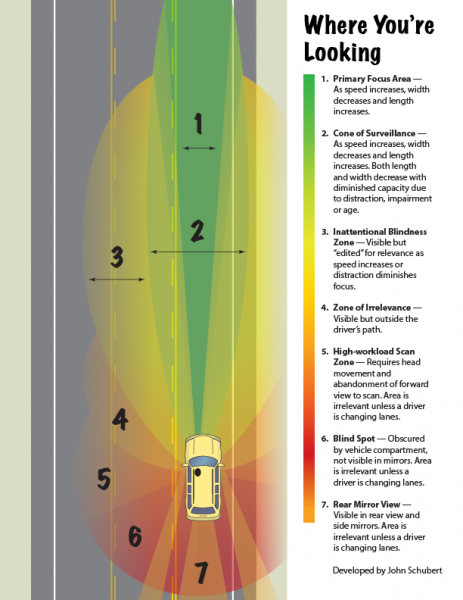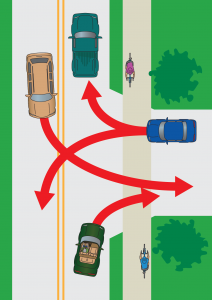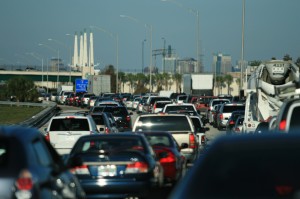Info for Motorists
- Sharing the Road with Bicycles
- Why do you ride like that?
- Laws for Motorists
- Avoiding Mistakes that Cause Crashes
Sharing: What does it mean?
The roads are a cooperative system. They are a common space in our communities where we all interact daily. Our conduct on the roads influences the quality and livability of our communities.
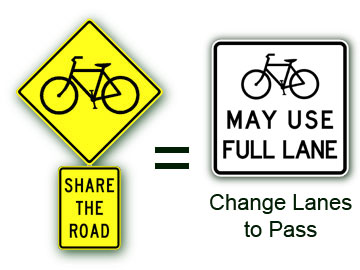 Share the Road signs indicate the likelihood of cyclists on the roadway. They are used where the road is not wide enough for bicycles and cars to be operated safely within one lane. Therefore, “share the road” means “one after the other.” The bicycle driver, or group of cyclists, has the right of “first come, first served” and the full use of lane. Motorists wishing to pass, must yield and wait until is is safe to do so.
Share the Road signs indicate the likelihood of cyclists on the roadway. They are used where the road is not wide enough for bicycles and cars to be operated safely within one lane. Therefore, “share the road” means “one after the other.” The bicycle driver, or group of cyclists, has the right of “first come, first served” and the full use of lane. Motorists wishing to pass, must yield and wait until is is safe to do so.
Bicycle drivers usually ride in the right half of the lane, to offer visibility and easier passing for motorists. But they are not required to stay out of the way or to share their lane if it is not wide enough for side-by-side operation. The best position for cyclists in a narrow lane is one that makes it clear to a following motorist that he or she must change lanes (typically, this is between the right tire track and the center of the lane, but varies based on many dynamic conditions). There are times when cyclists need to ride on the left side of the lane: to avoid a hazard or bad pavement; when traveling the speed of traffic; preparing for a left turn; or even to strongly discourage a motorist from passing when it is not safe.
Bike Lawyer, Steve Magas has an excellent article about why the concept of “sharing” fails cyclists.
Bicyclists are vehicle drivers, they belong on the road… and they are safer on the road.
Adult bicyclists do not belong on the sidewalk. Riding on the sidewalk is unsafe for cyclists and pedestrians. Cyclists on the sidewalk expose YOU, the motorist, to a higher risk of hitting them when you are entering or leaving the road — and you are likely to be at fault in such a crash.
Cyclists are not required to ride on the shoulder. They may choose to do so, but shoulders can present hazards to cyclists. Cyclists should never drive in the gutter or hug the curb. Many inexperienced riders do this because they don’t know it greatly increases their risk of crashing.
Successful bicyclists “Ride Big.” They ride well into the lane to increase their visibility to other drivers, give themselves operating room and discourage motorists from trying to squeeze past them in narrow lanes. See Why do you ride like that? in the left tab menu.
Pause and think it through.
Many conflicts and crashes are caused by impatient drivers. When you encounter a bicycle driver, take a moment to observe the roadway. In many cases it is not necessary to pass a cyclist right away, or at all:
- Is there a red light, stop sign or stopped traffic ahead?
- Is there an opportunity to pass with greater clearance in a short distance?
- Are there vehicles at cross streets that might turn into the oncoming lane as you are passing?
- Is the cyclist riding within a few mph of the speed limit?
- Are you on a residential street with speed bumps?
- Are you planning to turn off that road in 500 feet?
Once you have assessed the situation and determine it is safe and necessary to pass, give the cyclist plenty of space. The law requires at least 3 feet, but let’s be honest, you really can’t determine exactly where the right side of your car is in relation to what you are passing. Go ahead and change lanes, you can’t go wrong with that. On high-speed roads, reduce your speed as you pass. Even with plenty of clearance, it is not safe or considerate to pass an exposed human being at 70mph.
Take a deep breath, you have nothing to lose but stress.
Everyone is in a hurry. And lots of things get in the way: freight trains, red lights, other motorists, buses, etc. will all seem to be in your way throughout your journey.
Again, think before you pass. If there is stopped traffic, a stop sign, red light or speed bump ahead, you’ll gain nothing by passing. Save your gas.
A cyclist or group of cyclists in the road represents the most minor and momentary delay. Waiting a few seconds to pass a cyclist safely will not affect your total trip time at all. Injuring another road user because you are impatient and frustrated will cost you a lot more than a few seconds.
Purposely passing a cyclist too close with the intent to intimidate is ASSAULT. Passing too close at high speed because you are in a hurry is RECKLESS ENDANGERMENT.
If you see another motorist assault or endanger a cyclist, please call the police. We’re somebody’s daughter, son, mother, father, sister, brother, wife or husband. We might be your friend, neighbor, co-worker or doctor. Help us ensure the safety of Florida cyclists and the quality of our communities by driving cooperatively and reporting reckless driving and hostility.
Why do you ride like that?
Courtesy of CyclingSavvy
“Biking in the middle of the lane like that sure looks dangerous.”
Driving in the middle of the lane actually protects cyclists against the most common motorist-caused crashes: sideswipes, right hooks, left crosses, and drive-outs. A bicycle driver’s top safety priority is to ensure he or she can be seen by motorists with whom they might potentially be in conflict, and bicycling in the middle of a lane is one of the most effective ways to do that. Most overtaking crashes involve a motorist who attempts to squeeze past (illegally) in a lane that is too narrow to share.
This is the width of a typical lane with vehicles drawn to scale. None of the above vehicles are able to give the required 3ft of passing clearance without changing lanes. A cyclist is far more likely to be sideswiped than run over.
“I thought bicyclists had to keep all the way to the right.”
While Florida law [FS316.2065-5] does say bicyclists must drive “as close as practicable to the right-hand curb or edge of the roadway,” it also provides many exceptions to this rule, including:
- When overtaking and passing another vehicle
- When traveling at or near the same speed as other traffic
- When preparing for a left turn
- Where a lane is too narrow to share safely with another vehicle
- To avoid any condition that makes it unsafe to continue along the right-hand curb or edge
Many surface hazards – such as potholes, puddles, debris, and broken glass – are more common near the edge of the roadway.
Keeping to the right can often hide a bicyclist from a turning motorist at the critical time and place. Check out this animation to see all the hazards a bicycle driver faces when trying to stay to the right.
“Why weren’t you in the bike lane?”
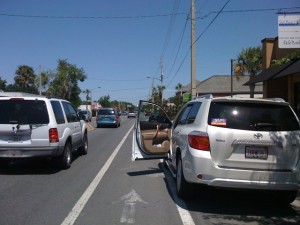
Anywhere in the bike lane a cyclist would be struck by this door. If the handlebar nicked the door, the cyclist would be thrown into the path of passing cars.
Most of the same reasons why bicyclists will drive towards the center of a lane are good reasons for leaving the bike lane, and Florida’s new mandatory bike lane use law allows cyclists the same exceptions as it does to keeping right in general. Here are just a few reasons:
- Bike lanes collect the debris and glass that is swept off the road. Sometimes you can see it because it’s big, like tree branches, but sometimes only we can see it. A small shard of glass can cause a flat tire. (How many tires did you change on your way to work today?)
- Many bike lanes are designed poorly or just plain dangerous. Bike lanes next to parked cars are often entirely within a hazard area we call “the door zone.” A suddenly-opened door can kill a cyclist.
- When approaching intersections, or in areas with lots of driveways, a bike lane puts us in a conflict zone (shown in the above animation). Bike lanes increase our risk for all of the common crossing and turning crashes.
- It may not be a bike lane. It has become popular to add edge lines several feet to the left of the curb. This space is substandard and not safe for a bicyclist to use, though many bicyclists are tricked into riding there.
Many of the reasons we avoid bike lanes are not visible or apparent to a person in a car. Of course, if a bike lane provides a clean, safe place to ride, we use it.
“Wouldn’t you just be safer biking on the sidewalk?”
While biking on the sidewalk would eliminate the very rare overtaking crash, it would increase the bicyclist’s risk for the far more common right hooks, left crosses, and drive-outs, and would make left turns far more complicated and less safe for the cyclist. Sidewalks present many more blind spots and physical hazards (such as poles, newspaper boxes, and intruding shrubs and tree limbs) than roadways do. If there’s a sidewalk on the left side of the road, but not the right side, cyclists would be traveling against the flow of traffic, which has been shown in traffic safety studies to increase the cyclist’s crash risk by a factor of four.
“You’re gonna get run over.”
Bicyclists across the nation who drive their bicycles in this manner have logged millions of miles without serious crashes or injuries. By comparison, bicyclists who hug the edge of the road, or ride on the sidewalk get into crashes much more frequently.
This video demonstrates why riding farther into the lane is not only safer for a cyclist, but creates less disruption for motorists.
“You’re impeding traffic.”
All road users impede other road users on a routine basis. A motorist waiting to make a left turn from a two-lane street will impede motorists behind him. Transit buses stop to pick up and drop off passengers. Pedestrians in crosswalks impede motorists who are required to yield to them. Convenience must take a back seat to safety. In our training courses we teach cyclists how to minimize the delay they might cause to other road users, while still driving in the safest possible manner.
It’s rare for a bicyclist to cause more than 30 seconds of delay to passing motorists. On the other hand, traffic lights are often as long as a 1:30, and some are 2:00.
“You’re supposed to ride single-file.”
Florida law allows bicyclists to travel two-abreast, provided doing so does not impede traffic. On streets where the lane is not wide enough the share, a solo bicyclist is allowed to ride in the middle of the lane anyway, so the presence of another bicyclist to her right is of little consequence. In the case of a group of cyclists, riding double shortens the group, which also shortens the distance needed to pass. You can learn more about group cycling on our Info for Group Riders page.
“Bicyclists don’t pay gas taxes, and shouldn’t be allowed on roads.”
Ah, where to begin… First, most bicyclists own and drive motor vehicles, buy gasoline for them, and therefore pay gas taxes. We all also pay gas taxes indirectly when pay for other goods and services; businesses pass along the costs of shipping and travel to customers.
But even if cyclists paid nothing, use of public rights-of-way is not contingent on payment of taxes. The Declaration of Independence does not say “all taxpayers are created equal,” but “all men are created equal” (meaning persons), and traveling along a public right-of-way is an essential liberty.
Many other taxes contribute to the construction and maintenance of public roads, including property taxes, sales taxes, impact fees, mobility fees, and more. Much of the gas tax is used to widen roads to accommodate more and more cars.
Gas taxes also go toward the construction of sidewalks along many roads. Using the same “don’t pay gas taxes” reasoning, school children should not be allowed to walk to school on sidewalks because they don’t pay gas taxes.
“Bicyclists should be required to have driver’s licenses.”
As with gas taxes, most do. But the reason people are required to be licensed to drive a motor vehicle is because they are inherently dangerous devices which pose a great danger to others. Motor vehicle drivers kill over 35,000 and injure over 2 million people a year in the United States. Careless or reckless motorists are a danger to everyone, while careless or reckless bicyclists are mostly a danger to themselves. If bicyclists should be required to be licensed, then so should pedestrians, as they pose about the same danger to others.
“Too many bicyclists think the laws don’t apply to them.”
We agree! We encourage and train bicyclists to drive their vehicles in the safest legal manner. Bicyclists who violate the law not only endanger themselves, they break the system of movement that makes us all able to coexist predictably. This creates animosity and degrades the community for all of us. Feel free to call the police (non-emergency number, please) when you see bicyclists doing the following: running red lights, blowing through stop signs, driving on the wrong side of the road (facing other traffic), and driving at night without front and rear lights. But please don’t call the police if you see one of us in the middle of the lane!
Legal Responsibilities of Motor Vehicle Drivers
Driver Responsibility to Exercise Care (Section 316.130, F.S.)
Notwithstanding other provisions of this chapter, every driver of a vehicle shall exercise due care to avoid colliding with any pedestrian or any person propelling a human-powered vehicle and give warning when necessary and exercise proper precaution upon observing any child or any obviously confused or incapacitated person.
Overtaking and Passing a Vehicle (Sections 316.083, 316.085, F.S.)
The driver of a vehicle overtaking another vehicle proceeding in the same direction shall pass to the left thereof at a safe distance and shall not again drive to the right side of the roadway until safely clear of the overtaken vehicle. A driver overtaking a bicycle must maintain a horizontal clearance of at least 3 feet [§316.083]. Three feet is a minimum “safe distance” for passing a cyclist under typical urban conditions; when the passing vehicle is large, towing a trailer, or traveling at much higher speed, greater lateral clearance is needed.
To pass a cyclist with safe clearance, it may be necessary for a motorist to enter (at least partially) the next lane, when and where it is safe to do so.
No vehicle shall be driven to the left side of the center of the roadway in overtaking and passing another vehicle proceeding in the same direction unless the left side is clearly visible and free of oncoming traffic for a sufficient distance ahead to permit passing to be made without interfering with the operation of any vehicle approaching from the opposite direction. In every event an overtaking vehicle must return to an authorized lane of travel as soon as practicable and, in the event the passing movement involves the use of a lane authorized for vehicles approaching from the opposite direction, before coming within 200 feet of any approaching vehicle [§316.085].
The Double Yellow Line: The prohibition of passing in a no-passing zone does not apply when an obstruction exists making it necessary to drive to the left of the center of the highway [§316.0875(3)]. Thus, when a cyclist is traveling so slowly as to constitute an “obstruction,” a motorist may cross the center line in a no-passing zone to pass the cyclist if the way is clear to do so, i.e., when it can be seen that any oncoming traffic is far enough ahead that the motorist could finish passing before coming within 200 feet of an oncoming vehicle.
About 1 percent of bicycle-motor vehicle crashes involve motorists who misjudge the width or length necessary to pass a cyclist. Close passing causes some cyclists to “hug the curb,” or ride on the sidewalk, where crash risk actually increases.
Driving Speeds (Sections 316.183, 316.185, F.S.)
No person shall drive a vehicle on a highway at a speed greater than is reasonable and prudent under the conditions and having regard to the actual and potential hazards then existing. In every event, speed shall be controlled as may be necessary to avoid colliding with any person, or vehicle on or entering the highway in compliance with legal requirements and the duty of all persons to use due care.
The driver of every vehicle shall drive at an appropriately reduced speed when approaching and going around a curve; approaching a hill crest; traveling upon any narrow or winding roadway; and when any special hazard exists with respect to pedestrians or other traffic or by reason of weather or highway conditions.
The fact that a driver is traveling at less than the speed limit does not relieve him of the duty to reduce speed in such conditions. A driver must reduce speed as necessary to avoid colliding with any person legally present on the street.
Opening and Closing Vehicle Doors (Section 316.2005, F.S.)
No person shall open any door on a motor vehicle unless and until it is reasonably safe to do so and can be done without interfering with the movement of other traffic, nor shall any person leave a door open on the side of a vehicle available to moving traffic for a period of time longer than necessary to load or unload passengers.
Avoiding the Mistakes that Cause Crashes
The information in this section is to help you, the motorist, avoid the mistakes that can lead to crashes. Regardless of who would be at fault, it is still in your interest to avoid hitting a cyclist.

Before turning right, scan the sidewalk for cyclists traveling in both directions. The ones traveling in your direction could be in your blind spot. If you pass a cyclist prior to turning, that cyclist may catch up to you as you slow to turn.
Right-hook: Motorist turning right hits a cyclist going straight.
Don’t pass a cyclist before making a right turn! Bicycles move faster than you think. Slow down and wait for the cyclist to clear the intersection. Move as close as practical to the curb prior to making the turn.
Keep in mind that cyclists on the sidewalk could be hidden from you by shrubbery, poles or utility boxes in the right-of-way. You must scan carefully for them before turning. Unlike pedestrians, cyclists on a conflicting path won’t be near the intersection, they could be 20-30ft away, traveling at 20ft per second. They can easily catch up to you as you slow to make the turn. This is why—contrary to popular belief—you are more likely to hit a cyclist on the sidewalk than one on the street.
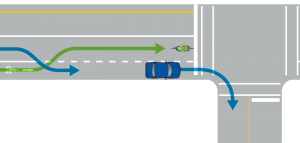
The right hook can be prevented by the motorist or the cyclist. Even if the cyclist does not leave the bike lane, you can yield, move into the bike lane behind the cyclist, and wait to turn.This is the legally-required method for turning right in Florida.
Whenever you are in slow-moving traffic it is especially critical to check your blind spots before turning — cyclists riding on the sidewalk or edge of the road could be overtaking on your right.
When driving on a road with a bike lane – look, signal and merge into the bike lane before turning right. Properly marked bike lane lines should be broken before an intersection to encourage motorists to merge right and cyclists to merge left. Be aware that if you have been sitting in slow traffic, a cyclist could be passing you on the right. ALWAYS look over your right shoulder before merging or turning right!
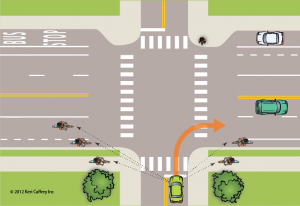
There are many places you need to scan for a cyclist before pulling out. Think about which one is most visible to you.
Drive-out: Motorist pulls out from a side street or driveway into a cyclist’s path.
Yield right-of-way to bicyclists just as you would any other vehicle. Don’t underestimate a cyclist’s speed, they can be faster than you think. Always stop behind the stop bar and be alert for bicycle riders on the sidewalk, or hugging the edge of the road. Also be aware that cyclists riding against the flow of traffic could be approaching from from your right. It is legal, though not a good idea, to ride against traffic on the sidewalk (where it is legal to ride on the sidewalk, that is). It is illegal for a bicyclist to ride against traffic on the roadway, however, it is still in your interest not to hit a bicyclist!
Remember, many quiet streets are bike routes. Always make a full stop and scan carefully before proceeding.
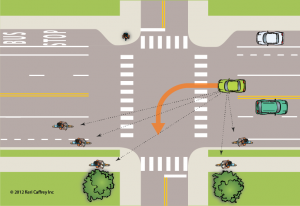
There are many places you need to scan for cyclists before making a left turn. Think about which of these cyclists is most visible to you.
Left-cross: motorist turns left into, or in front of, a cyclist.
Scan the whole roadway area, including the sidewalk, before turning left. Don’t underestimate a cyclist’s speed! You must yield to bicycles just as any other vehicle. Keep in mind that a cyclist operating alongside traffic (in a wide lane, a bike lane, or on the sidewalk) may be hidden from your view by overtaking vehicles. Make sure you can see that space before you turn. Also be aware that cyclists riding against the flow of traffic could be approaching from behind you. It is legal, though not a good idea, to ride against traffic on the sidewalk (where it is legal to ride on the sidewalk, that is). It is illegal for a bicyclist to ride against traffic on the roadway, however, it is still in your interest not to hit a bicyclist!
Side-swipe: Motorist misjudges passing clearance while trying to squeeze between cyclist and centerline, median or oncoming traffic.
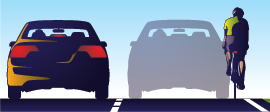
It’s so tempting to squeeze by a cyclist who is hugging the edge of the road. But your car may not fit there. In most cases, you cannot stay in the lane and give the cyclist the legal minimum passing clearance. Resist the urge! Wait a second and move over.
You are required by law to pass a cyclist with no less than 3 feet of clearance. Many cyclist ride too close to the edge of narrow lanes. It is very tempting to try to squeeze past them. But it is illegal! You must wait until it is safe to use part of another lane pass. If passing safely requires you to use part of an oncoming lane, you must have ample clearance to pass before coming within 200 feet of oncoming traffic.
Trailers and rental trucks, whose drivers don’t account for the width of their vehicles, are especially problematic for cyclists. If you are towing a trailer or driving a vehicle with extended mirrors, make sure you allow extra clearance.
Keep in mind that paint does not magically create passing clearance. There are many places where bike lanes are substandard, or next to very narrow general use lanes. You must move over to provide clearance to a cyclist in a bike lane.
The easiest way to ensure adequate clearance from a bicyclist is to change lanes.
Door prize: Motorist opens the door of a parked car into the cyclist.
This can be a deadly collision. Typically, the bike’s handle-bar hits the door, turning the front wheel to the right and sending the cyclist flying to the left – where the cyclist is then run over by overtaking traffic.
NEVER open your car door without looking for passing traffic. Many inexperienced cyclists ride too close to parked cars. Some bike lanes are striped within the reach of car doors. It is your responsibility to make sure the lane is clear before opening your door, whether that lane is a narrow traffic lane or a bike lane.
If you are driving and see a cyclist ahead operating in the door zone, slow down and pass with a wide berth. Anticipate your ability to react if that cyclist suddenly swerved or was ejected into the road in front of you.



